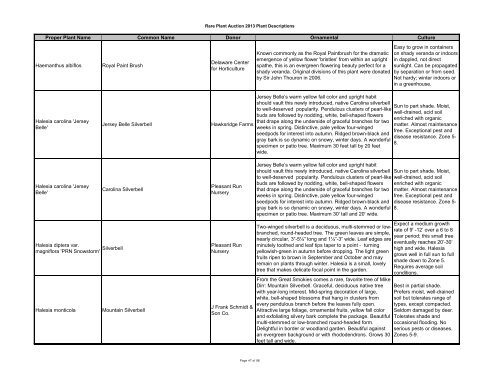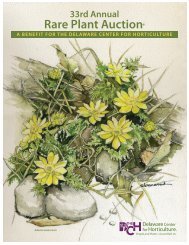Proper Plant Name Common Name Donor Ornamental Culture ...
Proper Plant Name Common Name Donor Ornamental Culture ...
Proper Plant Name Common Name Donor Ornamental Culture ...
Create successful ePaper yourself
Turn your PDF publications into a flip-book with our unique Google optimized e-Paper software.
Rare <strong>Plant</strong> Auction 2013 <strong>Plant</strong> Descriptions<strong>Proper</strong> <strong>Plant</strong> <strong>Name</strong> <strong>Common</strong> <strong>Name</strong> <strong>Donor</strong> <strong>Ornamental</strong> <strong>Culture</strong>Haemanthus albiflosRoyal Paint BrushDelaware Centerfor HorticultureKnown commonly as the Royal Paintbrush for the dramaticemergence of yellow flower 'bristles' from within an uprightspathe, this is an evergreen flowering beauty perfect for ashady veranda. Original divisions of this plant were donatedby Sir John Thouron in 2006.Easy to grow in containerson shady veranda or indoorsin dappled, not directsunlight. Can be propagatedby separation or from seed.Not hardy; winter indoors orin a greenhouse.Halesia carolina 'JerseyBelle'Jersey Belle SilverbellHawksridge FarmsJersey Belle’s warm yellow fall color and upright habitshould vault this newly introduced, native Carolina silverbellSun to part shade. Moist,to well-deserved popularity. Pendulous clusters of pearl-likewell-drained, acid soilbuds are followed by nodding, white, bell-shaped flowersenriched with organicthat drape along the underside of graceful branches for twomatter. Almost maintenanceweeks in spring. Distinctive, pale yellow four-wingedfree. Exceptional pest andseedpods for interest into autumn. Ridged brown-black anddisease resistance. Zone 5-gray bark is so dynamic on snowy, winter days. A wonderful8.specimen or patio tree. Maximum 30 feet tall by 20 feetwide.Halesia carolina 'JerseyBelle'Carolina SilverbellPleasant RunNurseryJersey Belle’s warm yellow fall color and upright habitshould vault this newly introduced, native Carolina silverbell Sun to part shade. Moist,to well-deserved popularity. Pendulous clusters of pearl-like well-drained, acid soilbuds are followed by nodding, white, bell-shaped flowers enriched with organicthat drape along the underside of graceful branches for two matter. Almost maintenanceweeks in spring. Distinctive, pale yellow four-winged free. Exceptional pest andseedpods for interest into autumn. Ridged brown-black and disease resistance. Zone 5-gray bark is so dynamic on snowy, winter days. A wonderful 8.specimen or patio tree. Maximum 30' tall and 20' wide.Halesia diptera var.Silverbellmagniflora 'PRN Snowstorm'Halesia monticolaMountain SilverbellPleasant RunNurseryJ Frank Schmidt &Son Co.Two-winged silverbell is a deciduous, multi-stemmed or lowbranched,round-headed tree. The green leaves are simple,nearly circular, 3”-5½” long and 1½”-3” wide. Leaf edges areminutely toothed and leaf tips taper to a point - turningyellowish-green in autumn before dropping. The light greenfruits ripen to brown in September and October and mayremain on plants through winter. Halesia is a small, lovelytree that makes delicate focal point in the garden.From the Great Smokies comes a rare, favorite tree of MikeDirr: Mountain Silverbell. Graceful, deciduous native treewith year-long interest. Mid-spring decoration of large,white, bell-shaped blossoms that hang in clusters fromevery pendulous branch before the leaves fully open.Attractive large foliage, ornamental fruits, yellow fall colorand exfoliating silvery bark complete the package. Beautifulmulti-stemmed or low-branched round-headed form.Delightful in border or woodland garden. Beautiful againstan evergreen background or with rhododendrons. Grows 30feet tall and wide.Expect a medium growthrate of 9' -12’ over a 6 to 8year period; this small treeeventually reaches 20’-30’high and wide. Halesiagrows well in full sun to fullshade down to Zone 5.Requires average soilconditions.Best in partial shade.Prefers moist, well-drainedsoil but tolerates range oftypes, except compacted.Seldom damaged by deer.Tolerates shade andoccasional flooding. Noserious pests or diseases.Zones 5-9.Page 47 of 98




